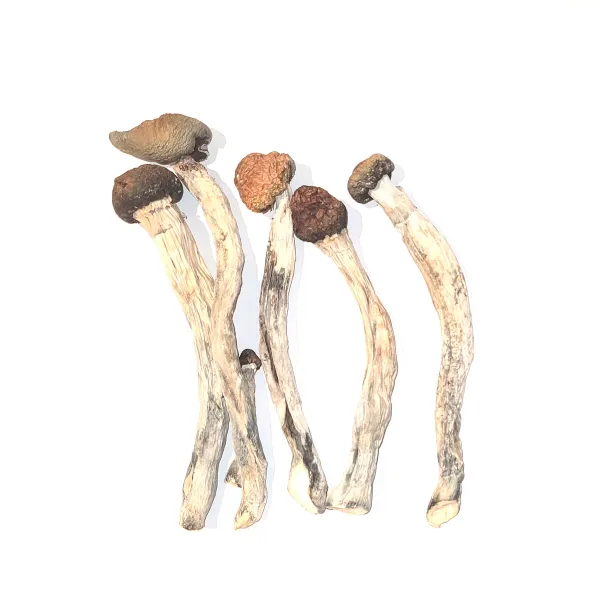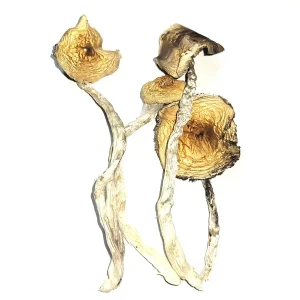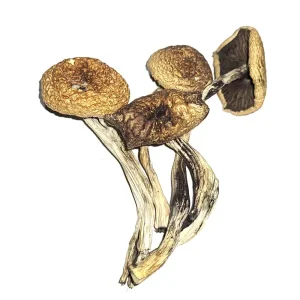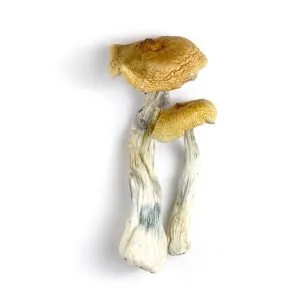Magic Mushrooms For Sale:- Psilocybe Tampanensis Mushroom.
Most magic truffles are Psilocybe tampanensis — however, it’s also possible to harvest magic truffles from Psilocybe mexicana. In the Netherlands, the fruiting bodies of magic mushroom species are illegal, but the non-reproductive parts aren’t. This has led to the widespread cultivation of P. tampanensis because of its ability to form psilocybin-rich sclerotia — which are masses of mycelia that form underground. Psilocybe tampanensis
Sometimes referred to as “Philosopher’s stones” or “magic truffles”, you can find this species at most mushroom dispensaries and coffee shops in places like Amsterdam.
This species is very easy to cultivate at home but requires some tweaks compared to conventional magic mushroom cultivation to maximize sclerotia or truffle formation. psilocybe tampanensis spores
It’s rare to find this species in the wild, but there are reports of people collecting samples in Florida and other parts of the tropical US.
Buy Psilocybe Tampanensis Online
Psilocybe tampanensis is a peculiar species with underwhelming, small, brown mushrooms. What lies below the surface of these mushrooms is much more impressive. This species produces large masses of sclerotia — dense, truffle-like clumps of mycelium. As are the mushrooms, these “magic truffles” are psychedelic. psilocybe tampanensis spores
P. tampanensis was one of the first species cultivated for magic truffle production, and it kick-started the truffle market in the Netherlands, essentially saving the psilocybin scene when magic mushrooms were made illegal in 2008.
This mushroom species is loved by many, and it’s responsible for several important milestones in psychedelic history. Let me tell you more about it. growing psilocybe tampanensis
What Is Psilocybe tampanensis?
Psilocybe tampanensis is a rare psychedelic mushroom species originally collected from a meadow in Tampa, Florida, in 1977. Discovered by the legendary mycologist and “Mushroom Doctor” Steven Pollock, this species is unique in that it produces “sclerotia” (magic truffles) that can grow to enormous sizes. psilocybe tampanensis truffles
Sclerotium is a mass of densely packed mycelium. In the psychedelic space, the sclerotia of psilocybin mushrooms are called magic truffles. However, they aren’t reproductive structures like traditional edible truffles are. Instead, these growths have the primary function of preserving the mushroom species through times of hardship.
Sclerotia can survive underground indefinitely — ensuring the longevity of the species. These clumps of mycelium can remain alive and dormant underground through long, harsh winters or periods of drought until conditions improve enough to support mushroom growth. psilocybe tampanensis potency
This species is often overlooked — they’re small, brown, and relatively unassuming. Even though P. tampanensis is largely cultivated, its mycelium is rarely left to fruit — cultivators are more interested in growing its sclerotia. psilocybe tampanensis wild
P. tampanensis mushrooms and truffles are relatively weak in terms of potency — producing psilocybin levels comparable to a low-potency strain of Psilocybe cubensis. That said, when over five grams of this species’ mushrooms or sclerotia are consumed, the user can experience deep introspection, an intense body high, and moderate visuals.
The History of Psilocybe tampanensis
The history of Psilocybe tampanensis is rather intriguing. There’s quite a story to this shroom, as it once disappeared entirely.
Let’s delve into the mysterious history of P. tampanensis and find out how it rose to fame…
Psilocybe tampanensis was discovered in 1977 by none other than Steven Hyaden Pollock — a renowned mycologist who is often credited with the establishment of the famous Penis Envy strain of Psilocybe cubensis.
Pollock found the first sample of this rare Psilocybe species in Tampa, Florida — hence its species epithet “tampanensis.” He stumbled across the mushrooms while mushroom hunting in a sandy meadow grazed by Braham cattle with close friend and fellow mycologist Gary Lincoff. Although relatively boring in appearance, Pollock became rather intrigued with it.
He brought the specimen back to his remote Winnebago laboratory, where he dissected it and excised a small piece of stem tissue to an agar culture. While driving back from Tampa to his base in San Antonio, Pollock observed mycelial growth on one of the agar plates.
Some weeks later, he noticed something unusual about the Psilocybe tampanensis agar dishes. The mycelium began to glisten and form small, hard granules. He discovered a unique treasure that would change the course of his cultivation efforts entirely.
The Potency & Effects of Psilocybe tampanensis
Psilocybe tampanensis is relatively weak in terms of potency. Not much is known about the tryptamine content of the mushrooms this species produces, but there is some data on the potency of its sclerotia.
“Philosopher’s Stone” sclerotia produces somewhere around 0.70% total tryptamines — psilocybin, psilocin, baeocystin, and others. The psilocybin content is around 0.40%, and the psilocin content is around 0.20%. These levels can vary from truffle to truffle, with some more potent than others.
Unfortunately, very little information is available on the exact tryptamine levels of these truffles, which is surprising considering how popular they are in the Netherlands.
One thing is for sure: they’re not as strong as the typical “magic mushroom,” meaning larger doses are needed to induce noticeable psychedelic effects. Thanks to trip reports and first-hand experiences in Holland, we do have some information on these truffle’s effects.
You can expect light visual stimulation, a strong body high (feelings of euphoria and waves of energy), and increased sociability after a medium-level dose of Philosopher’s Stone truffles.
The effects of magic truffles include:
- Altered mood
- Changes in perception of self
- Distorted perception of time
- Enhanced creativity
- Euphoria
- Increased emotional intensity
- Increased empathy
- Increased introspection
- Increased sociability
- Spiritual (mystical) experiences
- Visual & auditory hallucinations
Magic Mushroom Species Potency Comparison
We’ve been developing a database to track the potency of various mushroom species. Here, we’ve ranked each species according to their combined psilocybin, psilocin, and baeocystin levels.
Psilocybe tampanensis currently ranks 9th on the list.
Related Articles: Strongest Magic Mushroom Species & Average Magic Mushroom Potency for more information.
What’s the Dose of Psilocybe tampanensis Mushrooms?
Unlike most magic mushrooms, eating a gram or two of Psilocybe tampanensis sclerotia won’t induce any psychoactive effects. The psilocybin and psilocin levels found in Philosopher’s Stone truffles are far lower than most other magic mushroom species. Therefore, a larger dose (in weight) is needed to induce a psychedelic trip.
Five grams or more of fresh Psilocybe tampanensis truffles are needed to feel any psychedelic effects, and even a dose of this level can be considered a “macrodose” — a mild psychedelic dose.
To induce a strong psychedelic trip comparable to 3.5 to 5 grams of dried Psilocybe cubensis mushrooms, 10 grams or more of fresh Philosopher’s Stones must be consumed.
Here are the rough doses in fresh weight for Psilocybe tampanensis sclerotia:
Psilocybe tampanensis is a popular truffle for microdosing, especially in Europe, where they can be purchased from vendors based in the Netherlands. Commercial cultivators of P. tampanensis sclerotia tend to harvest the truffles when pea-sized because harvesting them when larger means waiting for several months.
The small size of these truffles makes them the perfect candidates for microdosing. Each pea-sized truffle weighs around 1 gram (fresh) — enough psilocybin to benefit from without inducing psychedelic effects.
Magic truffle microdoses are available to purchase from several companies based in the Netherlands, and there are a few in the US and Canada. Keep in mind that although many Netherlands-based microdose companies will ship throughout Europe, psilocybin is a restricted substance in many countries. You could face charges if magic truffle microdoses are ordered in a restricted country.
Here’s where you can buy P. tampanensis microdoses: Psyttraxx
Where Can You Find Psilocybe tampanensis Mushrooms?
Psilocybe tampanensis mushrooms are hard to come by in the wild, So you find and order them directly online from PSYTTRAXX. Although spore samples are easy to get through a selection of spore vendors worldwide, this species is much more challenging to come by in the wild. They grow in a very select region of the United States and Mexico.
These mushrooms grow in the eastern part of the United States in the subtropical regions from Florida and down the Gulf Coast to Texas, extending into northwestern Mexico.
Psilocybe tampanensis is a subtropical species that’s extremely rare. There are very few records of this mushroom, and it isn’t easy to find. The mushrooms grow solitary or in small clusters of two or three fruits. They like sandy soils and free-draining meadows and pastures.
How to Identify Psilocybe tampanensis
Psilocybe tampanensis can be a difficult species to identify in the wild because of its rarity. Several similar species can be mistaken for it. It’s far easier and safer to cultivate this species at home.
If you’re lucky enough to find a P. tampanensis specimen in the wild, you’ll probably be underwhelmed by its appearance. They’re a dull-brown color, small, and “leggy” — tall and slender.
Related: Mushroom Anatomy 101
With that said, here are the defining features of P. tampanensis:
1. Mushroom Caps
The caps of Psilocybe tampanensis mushrooms range in shape from conical (cone-shaped) to convex (outwardly rounded) and slightly umbilicate (flat with a small central depression).
The caps are hygrophanous, with a caramel-brown color when wet and a yellowish-gray color when dry. They have a diameter of between 1 and 2.5 centimeters (0.4 to 0.9 inches) — they’re easy to miss since they blend in with the sandy soils and dry, golden grass.
The surface is smooth without bumps or blemishes and is somewhat sticky when wet — bruising blue when damaged.
2. Gills
The gills of Psilocybe tampanensis are adnate (broadly attached with an indent around the stipe). They are brown to dark purple — darkening as the mushrooms mature and begin to sporulate.
3. Stipe (Stem)
The stipe of Psilocybe tampanensis is thin and leggy, ranging from 2 to 6 centimeters (0.8 to 2.4 inches) long and 1 to 2 mm (0.04 to 0.08 inches) thick. They are creamy white to caramel brown and bruise blue when damaged or disturbed.
They have an equal length from the base to the cap, with a slightly enlarged basal bulb. The partial veil is present in young mushrooms but soon disappears, leaving no annulus on the stipe.
4. Spores
The P. tampanensis spore print is purple-brown to black. The spores themselves are rhombic when you view them face-on and roughly elliptical from the side view. When viewed under a microscope, the spores appear yellowish-brown and have a thick, smooth wall and a distinct germ pore.
Spore dimensions: 8.8 to 9.9 by 8 to 8.8 by 5.5 to 6.6 μm (micrometers).
The basidia (spore-bearing structures) are four-spored, translucent, and measure 14 to 22 by 8 to 10 μm.
5. Sclerotium
The sclerotia (magic truffles) of P. tampanensis range in size, but they’re generally 1 to 3 centimeters (0.4 to 1.2 inches) — similar in size to a walnut. However, they can grow much larger — occasionally as large as a tennis ball. They are rusty brown to tan with light gray features.
Each sclerotia nodule resembles a small tuber, such as those produced by Zingiber officinale (ginger) or Curcuma longa (turmeric). Their texture is firm, dense, and rubbery, and the scent is strong, earthy, and slightly sour.
Psilocybe tampanensis Look-Alikes
Psilocybe tampanensis has several potential look-alikes. Mistaking a similar-looking species for P. tampanensis is highly likely due to the rarity of its mushrooms.
Picking and consuming one of these look-alikes could prove fatal — many similar species produce deadly amatoxins that can cause severe stomach discomfort, vomiting, liver and kidney damage, and, in worse cases, death through organ failure.
We do not recommend searching for this species unless you’re an experienced mycologist/mushroom forager. If you’re new to mushroom hunting and want to seek out psychedelic fungi, we recommend looking at Psilocybe cyanescens, Panaeolus cyanescens, Psilocybe semilanceata, or Psilocybe cubensis.
Can You Grow Psilocybe tampanensis At Home?
Yes. It’s possible to grow Psilocybe tampanensis mushrooms and produce psychedelic sclerotia at home.
If you’re interested in growing magic mushrooms, this species isn’t recommended for beginners. People new to mushroom cultivation should start with an “easily cultivated species” such as Psilocybe cubensis. However, for those interested in producing sclerotia, this is a great species to start with.
Due to the lack of a “fruiting phase,” cultivating magic truffles is relatively straightforward. As long as the substrate is sterilized and no contaminants are introduced during inoculation, cultivating P. tampanensis is as easy as baking a cake. However, growing truffles is a bit like watching paint dry — it takes a long time.
How to Cultivate Psilocybe tampanensis
It’s surprisingly simple to cultivate Psilocybe tampanensis sclerotia (Philosopher’s Stones). The process is remarkably similar to growing magic mushrooms. However, rather than fruiting the mycelium so it produces mushrooms, it’s left until sclerotia forms from the mycelium.
Growing magic truffles of any species is a waiting game. It can take over four months to produce Philosopher’s Stones, even longer if you want to produce larger truffles — the longer you wait before harvesting, the larger the truffles will be.
Here’s a rundown of the cultivation process:
Step 1: Preparing the Substrate
The best substrate for growing Philosopher’s Stone truffles is grass seed. However, other grains, such as rye grain or a birdseed mix, will work too. If you use grass seed, ensure the seed is uncoated and untreated.
In a large bowl or bucket, mix ten parts of grass seed with five parts of water — for example, 1000 grams of grass seed will require 500 milliliters of water. Leave the mixture for an hour or so to absorb the water.
Take a mushroom grow bag, such as those used to cultivate oyster mushrooms, and fill it with the seed and water mixture. Then, place the bags into a pressure cooker with a small amount of water in the base. “Cook” the bag at 15 psi for an hour. After an hour, let the pressure cooker naturally depressurize and cool down completely — this will take a few hours.
Step 2: Inoculating the Substrate
Once the substrate-filled bag has completely cooled, remove it from the pressure cooker. The bags are completely sealed, so you don’t have to worry too much about sterilizing your surroundings. However, it’s good practice to give everything around you a wipe with isopropyl alcohol.
Heat the needle of a syringe filled with P. tampanensis spores using a cigarette lighter to sterilize it. Once cooled (30 seconds to a minute), inject the grow bag with 4 to 8 CCs of the liquid. The grow bag should have a small mesh tab for inserting the needle without introducing contaminants.
Step 3: Incubation
Once inoculated, the mushroom grow bag should be kept in a warm, dark place. Ideally, the temperature around the bag should be between 21 °C to 25 °C (70 °F to 77 °F). A boiler room or cupboard is a great place to store the bag.
Monitor the temperature surrounding the bag regularly, and occasionally, shake it to disperse the mycelium and encourage it to form evenly across the substrate.
The bag is ready for the next step once the substrate is entirely white with mycelium.
Step 4: Waiting for the Truffles to Form
Once the grow bag has completely colonized with mycelium, you’ll need to leave it alone and wait… and wait, and wait…
After several weeks, you’ll start to notice the formation of sclerotia. Avoid the temptation to open the bag and harvest a few — this will introduce contaminants that promote mold growth and encourage the mycelium to produce mushrooms.
After three to four months, the truffles should be large enough to harvest. You can leave the colony for up to eight months before harvesting — the longer you wait, the larger the truffles will be. However, keep a close eye on the bag and harvest the truffles immediately if you see any subtle signs of mold.
Step 5: Harvesting the Mushrooms
After several months, the truffles will be ready to harvest. When the time comes, open the bag and pour the substrate into a large, shallow box.
Sift through the substrate and “dig for your gold.” You should find several dense truffles throughout the substrate — simply remove them, brush them clean, and store them.
Are Psilocybe tampanensis Mushrooms Legal?
Both Psilocybe tampanensis mushrooms and truffles produce the psychedelic compound psilocybin. Although these shrooms grow in the wild, they’re illegal to pick and consume in their native habitat — Tampa, Florida — and elsewhere.
Psilocybin is a restricted substance in most countries, which makes the cultivation, consumption, and ownership of Psilocybe tampanensis mushrooms and truffles illegal. Getting caught with a bag of Philosopher’s Stones could land you a hefty fine or jail time in the United States, the United Kingdom, and most of Europe.
That said, there are a few exceptions, and certain countries and regions are relaxing their laws around psychedelic substances. Some countries still have restrictions, but the police rarely enforce the laws, meaning shrooms and truffles are illegal, but you’re unlikely to face penalties for owning or consuming them.
Let’s take a look at the legality of P. tampanensis country by country:
1. Canada
In Canada, the production, sale, and possession of psilocybin mushrooms and truffles are illegal. However, several magic mushroom shops are popping up across the country in major cities and towns and online. Although these stores get raided from time to time, they are mostly ignored by law enforcement.
The police in Canada seem to turn a pretend to the production, sale, and consumption of magic mushrooms and truffles. Buying magic truffles in the country is incredibly easy and low-risk. The postal laws in Canada also make it illegal for law enforcement to intercept packages, meaning psychedelic substances can be sold online within Canada without the risk of an order being seized.
This relaxed attitude toward magic mushrooms and truffles is similar to how cannabis was before it became legal in Canada. We can expect psilocybin to head in a similar direction, eventually becoming legalized and regulated by the government.
2. The United States
In the United States, psilocybin remains illegal under federal law. It’s also a restricted substance under state law in most states. However, there are a few exceptions, and a handful of states have altered their legislation surrounding magic mushrooms and truffles.
Some states have legalized or decriminalized psilocybin for medical and/or recreational use. Other states haven’t reversed or relaxed laws state-wide, but certain municipalities within the state have altered their legislation.
Here are the US states that have altered their legislation on psilocybin in some way:
It’s important to note that although it’s possible to order magic truffles online in the US, the postal laws are different from Canada. The authorities can intercept packages, making it somewhat risky to order controlled substances via the Internet.
3. Europe
In Europe, magic mushrooms and truffles are illegal in most countries. However, in the Netherlands, magic truffles are legal and can be purchased from a variety of vendors known as “Smart Shops” across the country. Strangely, dried truffles are illegal to sell, so most vendors vacuum pack and refrigerate them. It’s important to buy magic truffles from a reliable vendor that doesn’t overstore their truffles.
Magic mushrooms were once legal in Holland, but they were criminalized in 2008. A “loophole” in the law meant that truffles could still be sold and consumed without penalty. This led to a boom in the truffle market, and species such as Psilocybe mexicana and Psilocybe tampanensis began appearing all over the country.
Further south in Europe, Portugal has decriminalized all drugs. Psilocybin mushrooms and sclerotia aren’t technically legal and can’t be purchased from any legitimate vendors, but possessing small amounts and consuming them won’t land you in jail.
In Austria, psilocybin has been decriminalized. You can possess and cultivate magic mushrooms and truffles, but the law states that they must not be produced for use as a “drug.”
In most other countries in Europe, shrooms and magic truffles are illegal. However, it’s possible to buy viable magic mushroom spores legally. These spores can be cultivated to produce psilocybin mushrooms and sclerotia, but once they begin to grow, they become illegal.





Reviews
There are no reviews yet.